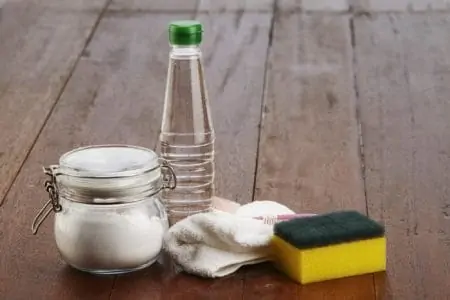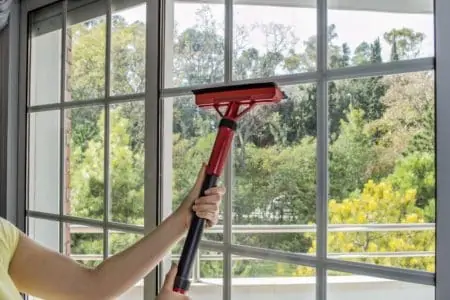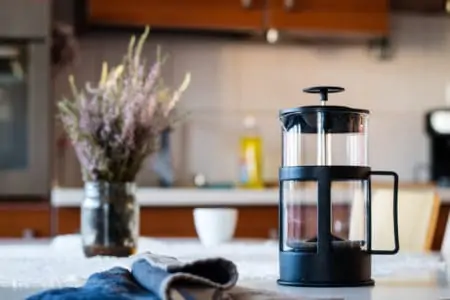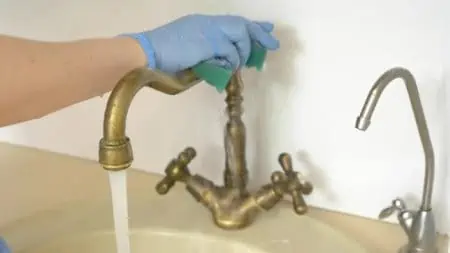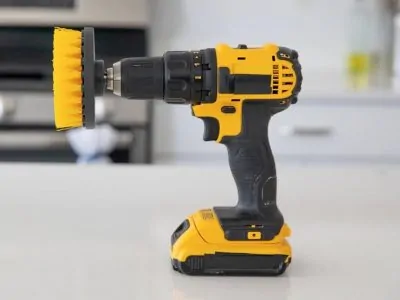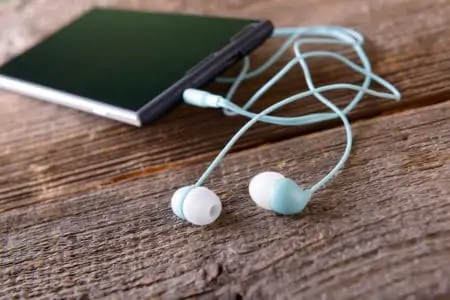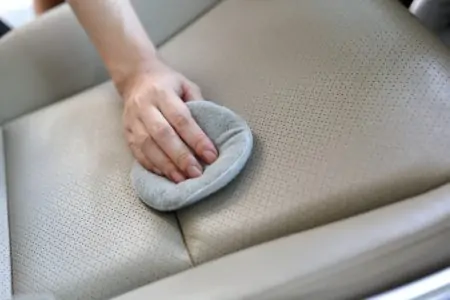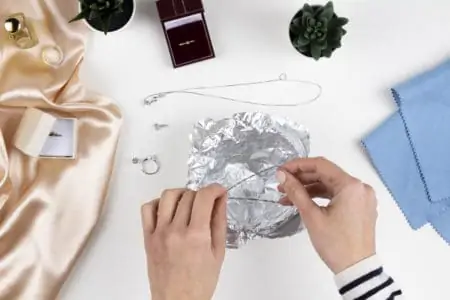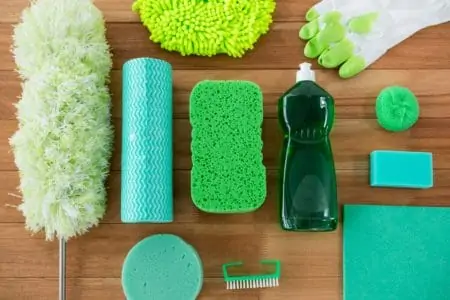Vinegar is a fantastic non-toxic and eco-friendly cleaner you probably already have in the house. If you have something that needs cleaning ASAP but you aren’t sure what to use, there’s a good chance distilled white vinegar will come in handy.
We always keep a five-liter bottle of distilled white vinegar in our cupboard and swear by it. But what can you clean with vinegar?
Here’s a list of 30 things you can clean with vinegar. Keep reading to be wowed by the power of this natural substance.
Key Takeaways
- Vinegar is a non-toxic cleaner that can break down dirt, grime, grease, and kill bacteria.
- It can be used to clean surfaces, appliances, sinks, drains, and even fabrics such as towels and clothes.
- However, avoid using vinegar on certain materials like granite, marble, stone tiles, and hardwood floors.
- Always check the manufacturer’s instructions before using vinegar on appliances and devices.
What to Clean With Vinegar
Vinegar is good for cleaning because it’s made from acetic acid (1). This acid can break down dirt, grime, grease, and it can even kill some bacteria. Here are 30 things you can clean with vinegar.
1. Tabletops
After a meal, spray vinegar over your tabletops and give them a good clean. The acid will break down dirt and grime from any spills. You can mix it with a 50:50 solution of water in a spray bottle.
Top Tip
Add a few drops of your favorite essential oil to mask the pungent smell of the vinegar.
2. Windows
White vinegar is a great window cleaner. Mix a 50:50 ratio with water and spritz it all over a microfiber cloth. Gently wipe the windows with the solution for a streak-free shine.
3. Dishwashers
This is one of our favorite hacks! Distilled white vinegar can break down all that gunk that builds up in your dishwasher. Once a month, place one cup of vinegar in the dishwasher and turn it on the highest heat setting. This will deep clean the inside of the machine with no effort from you whatsoever.
4. Sinks
Deep clean your kitchen sink with vinegar. Spritz down the sink, or simply put the plug in and fill the sink with a little bit of vinegar and distribute with a sponge or cloth. This is a great alternative to other surface cleaners since vinegar is completely food-safe. Scrub well, then rinse away.
Vinegar is also good for cleaning the drains! So drain it away as you would with water, and it will clear out gunk and odors from your drains, too.
5. Inside the Fridge
Mix a 50:50 ratio of vinegar and water (essential oils are optional) and deep clean your fridge. This is better than using chemical multi-surface cleaners since it’s non-toxic and food-safe, making it safe for everything else in the fridge. Plus, it’s great at breaking down grease and grime build-up.
6. Coffee Machine
When was the last time you cleaned the coffee machine? You’re maybe not sure where to start, but distilled white vinegar is your go-to here. This will give it a deep clean and remove any build-up lingering in the machine. Pour it directly into the machine and run as normal. Then run it with water a few times to get rid of the vinegar smell.
Warning
Only do this if your manufacturer allows. Some coffee machines will not function this way.
7. No-Wax Floors
If you have floors that can’t be waxed, mix ½ cup of vinegar with half a gallon of warm water. Mop the floors with this solution, being sure to change the water as it gets dirty. Vinegar is a gentle cleaner that will protect your floors while deep cleaning them.
Try This
You can also use this tip on other floor types. Switch out your regular floor cleaner for vinegar!
8. Towels
Use vinegar to wash your towels, and you’ll be thanking us for a long time. Add your towels to your washing machine with ½ cup of white vinegar and no detergent. Set to the highest temperature your towels will allow and wash. This will pull out all the detergent residue and other gunk that builds up in the towels, as well as restoring the color, removing stains, odors and even making them soft to the touch.
9. Stovetops
Stovetops get really greasy. While your store-bought product may do a great job, vinegar works just as well — and it’s non-toxic. Mix a 50:50 solution of vinegar and water, spray all over the stovetop and grates, leave for a few minutes before wiping clean. The acidic quality of the vinegar will break down grease and grime.
10. Chopping Boards
Spray vinegar over your cutting boards — even wood ones — and scrub clean. It’s a non-toxic and safe way to get rid of nasty build-up on your cutting boards. It’s food-safe, too, giving you peace of mind.
11. Smelly Rooms
Have you located a bad smell in the house but aren’t sure what to do about it? Vinegar. You can mix a 50:50 solution of vinegar and water in a spray bottle and spritz it around the room onto the furniture, rugs, carpet, and other sources of odors.
Alternatively, you can leave bowls of white vinegar around the house, in closets, on shelves, in the fridge, and it will kill odors that way.
Add essential oils to mask the sour smell of the vinegar, but do note that it will fade pretty quickly anyway. So it’s not the end of the world if your room smells like vinegar for a couple of hours after spraying.
12. Microwave
This is how we clean our microwave every time! Mix a 1:4 solution of distilled white vinegar and water into a bowl. Put it in the microwave and turn it on for five minutes. After it’s finished, let it stand for three minutes because it will be scorching. Open the door and wipe down the inside with a cloth. The vinegar will have loosened all the gunk in the microwave, making it super easy to clean in only a couple of wipes.
Why does this work? The combination of steam from the water and the acid from the vinegar creates the perfect concoction for breaking down the grease and grime.
13. Carpet Stains
If you’re like us, carpet stains can send you into a panic. But with this hack, there’s reason to be chill. Mix one tablespoon of dish soap, one tablespoon of white vinegar, and two cups of warm water into a bowl. Apply it to the stain with a sponge and blot until the stain lifts.
14. Oven Trays
Oven trays can get really nasty over time. Deep clean them with baking soda and white vinegar. Mix half a cup of each with hot water in the sink. It will bubble and fizz, don’t worry. Add the oven trays to the water and let them soak for 30 minutes before flipping it over for another 30 minutes. After that, it will be super easy to scrub away the loosened residue with a sponge or scouring pad.
15. Plastic Containers
You know how plastic containers and Tupperware can become stained and discolored over time? Vinegar can fix that. Soak the containers in vinegar for a few minutes or up to an hour, then wash as normal. The acid in the vinegar will break down those pesky stains, making it easier to clean.
16. As a Rinse Aid
If you live in a hard water area, you’ll be no stranger to the water stains that cling to your dishes. When handwashing dishes, add some vinegar into the sink alongside your dish soap and water. If washing in the dishwasher, add a few cups of vinegar into the bottom of your dishwasher before washing as normal.
Before You Do
Make sure that the dishwasher soap and handwashing dish soap you use is suitable alongside vinegar. Some manufacturers state not to mix the soap with any other ingredients.
17. Cleaning Metals
Vinegar is a gentle and effective way to clean metals, sprucing them up and bringing back their shine. This removes tarnish on a variety of metals.
To use, you can mix ½ cup of white vinegar, one teaspoon of salt, and enough flour until you’ve created a paste. Apply it to the metal using a cloth or brush and let it sit for 15 minutes. Rinse with water. Polish with a separate dry cloth.
This is especially good for copper, brass, and pewter.
18. Fruit and Veg
Next time you come back from the store, don’t just rinse your fruit and veggies in water. Instead, mix a 3:1 solution of water and vinegar. Either pour directly over the fruit and veg and soak for a few minutes or spritz them using a spray bottle. Rinse well with water.
Vinegar can remove bacteria and pesticides clinging to the fruit and vegetables, and ultimately, let them last longer in the fridge!
19. Pots and Pans
Some pots and pans — like stainless steel and enamel — are beautifully cleaned up with vinegar. Vinegar can break down nasty residue that dish soap just isn’t tackling. Boil water and vinegar together and pour into the pots and pans. Let it sit for up to an hour while the vinegar’s acid works its magic. Wash as normal and rinse really well.
20. Bathrooms
Yep, you can clean pretty much your entire bathroom with vinegar! You can use straight vinegar in a spray bottle, or you can dilute it in a bit of water. It’s perfect for cleaning the countertops, the sinks, the drains, and even the toilet.
21. Showerhead
While we’re in the bathroom, clean the shower head with vinegar, too. Pour white vinegar into a plastic bag and tie it over the showerhead so that the showerhead is soaking in the solution. Leave overnight. In the morning, scrub well, removing any loosened residue. Rinse well, and enjoy an extra clean shower!
22. Bathtubs
Another feature in the bathroom to clean with vinegar is the bathtub, specifically if it has a layer of film build-up. Simply spray vinegar all over the bathtub. Then apply baking soda to a wet cloth and scrub the bathtub well. Rinse everything away with clean water.
23. Kettles
Pour a 1:1 solution of water and vinegar into your kettle, either electric or a stovetop option. Boil the kettle; the vinegar will work to descale the kettle, deep cleaning it. Rinse well with water. We like to boil ours a couple of times afterward to really remove any trace of the vinegar.
24. Mattress
Cleaning your mattress is one of those chores you probably don’t think about too much. But think about it — you sleep on it every single night. It gets dirty.
Mix white vinegar, a few drops of rubbing alcohol, and tea tree into a spray bottle. Spritz it all over your mattress, but don’t soak it. This will help to kill bacteria, bed bugs, and odors. Let it dry, then vacuum the mattress afterward.
25. Clothes
Did you know you can use vinegar in every cycle of laundry? It will remove detergent build-up and odors. Add one cup of white vinegar to the final rinse of your cycle and let the magic happen! For larger loads containing blankets and quilts, add two cups instead of one.
26. Fridge Water Dispenser
It’s important to clean the fridge water dispenser every once in a while. Dip an old toothbrush in vinegar and clean out the water spout. This will remove mold, mineral deposits, and other dirt that hides in there.
27. Wooden Furniture
It can be hard to find the perfect cleaning solution for wood furniture. Look no further than vinegar!
Mix ¼ cup of white vinegar with one cup of olive oil. Dip a cloth in the solution and gently rub it over the wooden furniture. This will clean it up as well as oil it to remove stains and create a protective layer. We do this on our wooden furniture, and it works a treat!
28. Steam Iron
To deep clean the inside of a steam iron, pour a 1:1 solution of vinegar and water into the reservoir. Turn the iron onto the steam setting and let it run for five minutes in the upright position. Unplug the iron, let it cool down, empty the reservoir and wipe off the soleplate with a clean cloth. This will clean the inside and remove hard water deposits.
29. Trash Can
Spritz the inside of your trash can and lid with a 1:1 solution of vinegar and water. Wipe with a cloth. This will remove odors and break down grease and grime build-up. You should aim to do this between every bag change to stay on top of the dirt in the trash can. Let it dry before adding your bag.
30. Washing Machine
If the manufacturer allows, you can use vinegar to deep clean your washing machine once a month. Simply add one cup of vinegar to the drum or detergent dispenser. Turn the washing machine onto the highest setting or the drum clean setting, and let the hot water and vinegar deep clean and sanitize the drum.
What Not to Clean With Vinegar
While it may seem that you can clean anything and everything with vinegar, stop right there. There are some things you should never clean with vinegar.
1. Knives
While you can clean a knife block with vinegar, don’t clean your knives. Even if there is grease and grime build-up on the blades, vinegar is a bad idea as it can wear down the sharp edges. Instead, use warm soapy water or whatever else the manufacturer suggests.
2. Granite and Marble
While you can use vinegar to clean your surfaces, that doesn’t mean all surfaces. You should never clean granite and marble surfaces with vinegar. The acid in the vinegar can wear down the shiny glossy finish on these beautiful countertops over time.
3. Stone Tiles
Don’t clean natural stone with vinegar. You may find natural stone in your shower, bathroom, or your kitchen. The acidic quality of vinegar can damage the stone, so be sure to use a stone-specific cleaner instead.
4. Dropped Egg
This may seem weirdly specific, but it came up a lot in our research. If you’ve dropped an egg on the floor, don’t use vinegar to clean it up. This can harden the egg, making it really difficult to clean up.
5. Digital Devices
You may see experts advising you to create a vinegar-based cleaner for your phone, camera, and other technical devices. But we recommend against that. The vinegar can ruin your touchscreen devices and other coatings. There are specific products designed for electronic devices, so we recommend using those alongside a microfiber cloth.
6. Certain Appliances
While we recommend cleaning your dishwasher, kettle, coffee machine, washing machine, and other appliances with vinegar, you should be careful. Vinegar can break down some plastic and rubber parts of these machines. Always check the manufacturer’s advice and user manual before using vinegar on these products.
7. Hardwood Floors
You can use vinegar on certain floors, but avoid using it on hardwood. It may damage the finish on the hardwood floors. There are some amazing hardwood cleaners out there, which you should reach for instead.
FAQs About Cleaning With Vinegar
Victory With Vinegar
Vinegar is a very effective cleaner that will come in handy in all kinds of situations. Keep a bulk supply in the cupboard, and you’ll be surprised by how often you use it.
There are 30 different instances where you can use white vinegar, but keep in mind the seven times you should never use it.
